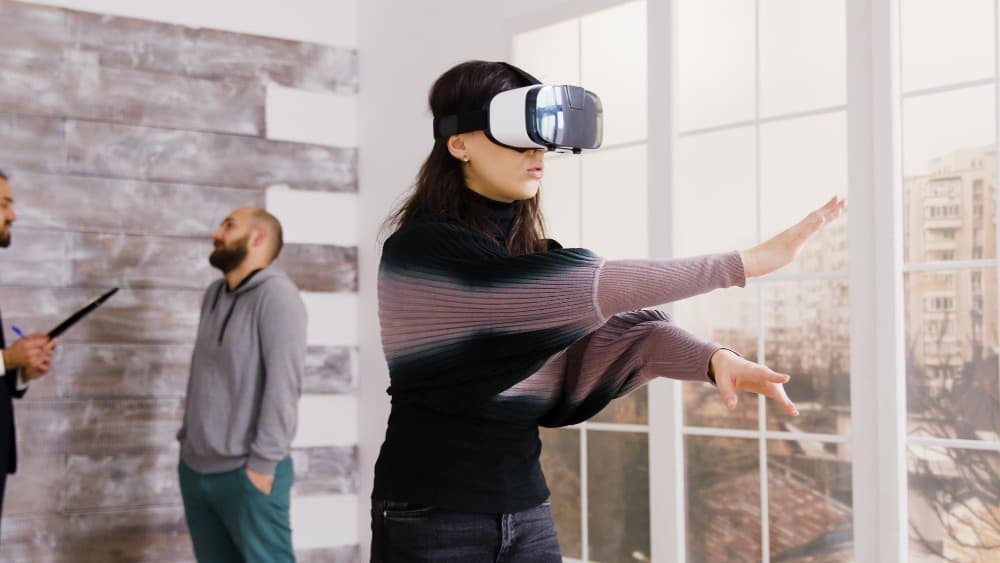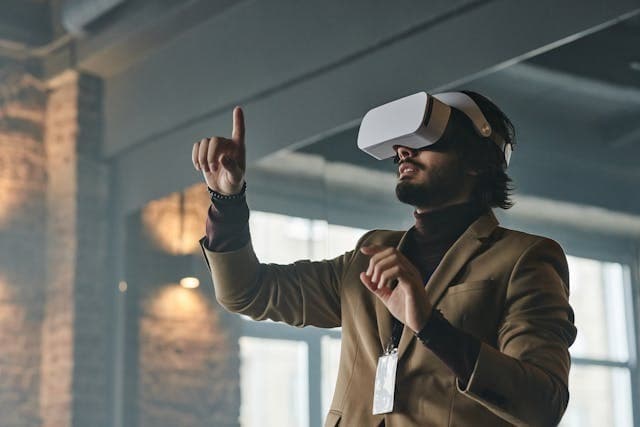Virtual Reality in Construction: Redefining the Future with Immersive Tech
The construction sector is entering a new digital era, one where immersive, interactive simulations are replacing physical blueprints and 2D models. Virtual Reality in construction enables architects, engineers, and contractors to visualize, plan, and collaborate on projects with unmatched precision.
This article explores how Virtual Reality is reshaping the construction industry, highlighting its key benefits, tools, applications, and the challenges companies face when implementing immersive construction solutions.
What is Virtual Reality in Construction?
Virtual Reality in construction refers to the use of computer-generated, immersive 3D environments that replicate real-world structures, job sites, or project designs. By wearing VR headsets or using projection systems, architects, engineers, and contractors can experience a project long before construction begins. Unlike traditional 2D blueprints or CAD drawings, VR allows stakeholders to walk through a virtual building, inspect design details, and identify potential issues in real time, improving accuracy and collaboration across teams.
This technology bridges the gap between concept and execution, helping professionals make informed decisions early in a project. Through immersive construction solutions, VR minimizes design errors, improves collaboration, and speeds up approvals, enabling firms to deliver safer, smarter, and more efficient projects.
How Virtual Reality is Transforming Construction
The integration of Virtual Reality in construction has evolved from a futuristic idea into a powerful operational tool driving construction industry transformation.
1. Design Visualization and Collaboration
Architects and engineers can now co-design projects in real time using VR environments. These immersive construction solutions allow multiple stakeholders to view the same 3D model simultaneously, detect design conflicts early, and adjust specifications collaboratively.
Firms like Turner Construction and Skanska have already implemented VR-based coordination sessions to reduce rework and enhance communication across distributed teams.
2. Training and Safety Simulations
Safety remains a primary concern in construction, and VR offers a breakthrough in this area. Workers can participate in virtual safety training that replicates on-site hazards, such as heavy machinery operation or fall prevention.
This approach enhances retention and reduces real-world risks, a key reason many U.S. firms now use VR to meet OSHA compliance training standards.
3. Client and Stakeholder Engagement
With VR walkthroughs, clients can experience their projects long before the first brick is laid. This eliminates misunderstandings, accelerates decision-making, and provides confidence in the outcome. It also adds value for construction firms offering immersive construction solutions as part of their design-build services.
4. Construction Planning and Sequencing
VR simulations help teams plan complex construction sequences, identify bottlenecks, and test logistics scenarios virtually. This capability reduces downtime and ensures smoother project execution.
Benefits of Virtual Reality in Construction
As the construction industry embraces digital transformation, Virtual Reality is emerging as a game-changing tool that enhances every stage of a project. Here are some of the most significant ways Virtual Reality in construction is transforming project delivery, improving collaboration, and driving industry efficiency.
1. Enhanced Collaboration and Communication
VR enables all stakeholders, from architects and contractors to clients, to collaborate within the same virtual environment, breaking down communication silos and reducing errors caused by misinterpretation.
2. Reduced Costs and Rework
By identifying design flaws and coordination issues before construction starts, VR helps prevent costly changes and material waste. This proactive approach minimizes project delays and maximizes resource efficiency.
3. Improved Safety Training
VR safety modules replicate dangerous situations in a risk-free setting, helping workers build confidence and skills without exposure to harm. This proactive approach lowers injury rates and improves compliance with safety standards.
4. Faster Project Approvals
Clients who can see and experience the final design are more likely to approve it quickly. This shortens approval cycles and boosts client satisfaction, an essential metric in B2B construction partnerships.
5. Sustainable and Efficient Design
Virtual models enable teams to simulate energy use and material performance before construction begins, helping achieve more sustainable outcomes and comply with LEED and EPA standards.
Most Impactful VR Applications in Construction
As VR applications in construction become more sophisticated, they are reshaping nearly every aspect of how firms design, plan, and execute projects. Below are the most impactful use cases transforming the construction industry today.

1. Virtual Design Reviews
One of the earliest and most popular VR applications in construction is virtual design review. Using immersive technology, project teams can explore and critique 3D models at full scale. Stakeholders identify issues related to spacing, layout, or accessibility long before construction begins, saving time and money.
2. BIM Integration
When combined with Building Information Modeling (BIM), VR creates a powerful ecosystem that connects digital design data with real-world visualization. Engineers and contractors can step inside a BIM model using VR headsets, analyze systems such as HVAC or electrical layouts, and verify coordination that traditional 2D plans can't match.
3. Construction Site Simulation
VR allows teams to simulate job site conditions, plan crane operations, and identify logistical challenges without setting foot on the site. These simulations enhance safety and efficiency by preventing conflicts between workers, materials, and machinery.
4. Virtual Mock-ups
Creating physical mock-ups is expensive and time-consuming. VR mock-ups offer several benefits, including detailed visualization, design validation, and stakeholder feedback at a fraction of the cost. Many B2B construction companies now present VR mock-ups during bidding to stand out from competitors and demonstrate project transparency.
5. Facility Management and Maintenance
After project completion, VR continues to add value. Facilities managers can use digital twins or virtual replicas of buildings to train maintenance staff, locate systems, and plan renovations effectively. This long-term utility makes immersive construction solutions a valuable investment beyond the build phase.
Virtual Reality Tools and Technologies Used in Construction
The success of Virtual Reality in construction relies heavily on the right combination of hardware, software, and integration tools. Below are the leading technologies powering the sector's digital transformation.
1. VR Hardware
Modern VR hardware offers high-resolution visuals and precise motion tracking. Common devices include:
Meta Quest 3 and HTC Vive Pro for immersive design walkthroughs
Varjo XR-4 headsets for photorealistic simulations and advanced engineering visualization
Haptic feedback gloves that allow users to "feel" textures or interact with virtual elements
These devices provide spatial accuracy critical for large-scale construction visualization.
2. VR Software Platforms
Leading VR software in construction integrates with CAD and BIM workflows to enable seamless visualization:
Unity Reflect and Unreal Engine: Used for creating interactive, real-time 3D environments.
IrisVR Prospect: Popular for architectural design reviews.
Enscape and Twinmotion: Known for real-time rendering and architectural walkthroughs.
3. BIM and VR Integration Tools
BIM-VR integration allows data-rich models to be imported directly into virtual environments. Platforms like Autodesk Revit Live and Navisworks make this connection possible, enabling construction teams to review design, sequence construction, and detect clashes visually.
4. Cloud-Based Collaboration Systems
With remote work becoming standard, cloud platforms such as Trimble Connect and Autodesk Construction Cloud host shared VR environments for cross-team collaboration. This ensures real-time communication, even across geographically distributed project teams, a critical advantage in B2B construction environments.
5. Mixed Reality (MR) and Augmented Reality (AR)
While Virtual Reality provides complete immersion, using Mixed Reality in construction combines virtual and physical elements. Tools like Microsoft HoloLens 2 overlay virtual components onto physical spaces, allowing field engineers to visualize plans directly on-site.
Challenges in Implementing Virtual Reality in Construction
Despite its advantages, implementing Virtual Reality in construction presents certain challenges that firms must navigate strategically.

1. High Initial Investment
VR equipment, software licensing, and training can require significant upfront costs. Although prices are decreasing, smaller construction firms may find it difficult to justify the investment without a clear ROI strategy.
2. Technical Skill Gaps
Adopting immersive technologies demands new digital skills that traditional construction workers may lack. Training teams to use VR tools effectively requires time and a well-structured change management approach.
3. Integration with Legacy Systems
Many construction companies still rely on outdated design or project management software. Integrating VR into these legacy systems can create compatibility issues or workflow disruptions.
4. Data Security and Privacy
With the use of cloud-based VR platforms, data security becomes a significant concern. Protecting sensitive project information and preventing unauthorized access are essential, particularly in public infrastructure projects.
5. Hardware Limitations
Although VR headsets have advanced, motion-tracking errors and visual discomfort can still occur during prolonged sessions. This is especially problematic for large teams conducting frequent virtual design reviews.
The Future Trend: Virtual Reality in Construction
The future of Virtual Reality in construction is poised for exponential growth as the technology matures and integrates with emerging innovations.
1. Integration with AI and Digital Twins
AI-driven digital twins will soon enable fully synchronized virtual models that mirror real-time site conditions. Project managers will be able to monitor progress, predict risks, and optimize operations using these intelligent virtual environments.
2. Greater Accessibility Through Cloud VR
Cloud computing is making VR more accessible. Instead of relying on high-end PCs, teams can stream immersive environments directly from lightweight devices, dramatically reducing hardware costs.
3. Enhanced Collaboration through 5G Connectivity
With the rollout of 5G networks, VR experiences will become more responsive and collaborative, even across remote teams. Faster data transfer will make real-time virtual meetings and site walkthroughs seamless.
4. Sustainability and Green Design Simulation
Sustainability is becoming a key driver in construction. Future VR tools will integrate environmental data to simulate carbon footprints, material efficiency, and energy performance before construction begins.
5. Democratization of VR
As hardware costs decline, VR will become standard across all project sizes, from large commercial builds to smaller residential developments. By 2030, most of the design and construction firms will integrate VR into their workflows to reduce rework while improving collaboration and accuracy.
Conclusion
Virtual Reality in construction is revolutionizing how projects are designed, planned, and executed. By merging visualization, collaboration, and analytics into a single immersive experience, VR is helping companies build smarter, safer, and more efficient. As adoption grows, VR is set to become a core pillar of modern construction, driving smarter, faster, and more sustainable project delivery.
Looking to bring the same immersive power to your brand? Flam helps businesses create interactive, 3D experiences that captivate audiences and drive engagement. Explore how Flam can turn your vision into reality.
Comments
Your comment has been submitted successfully!